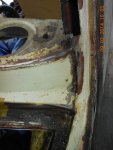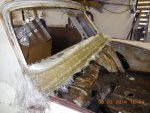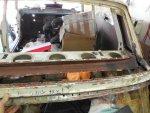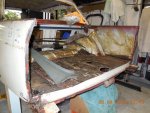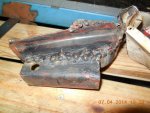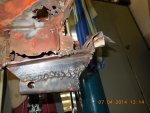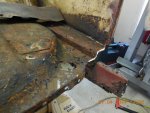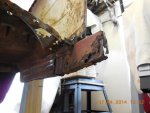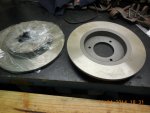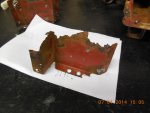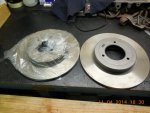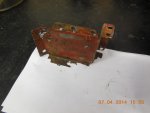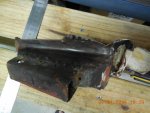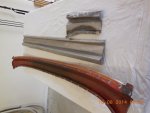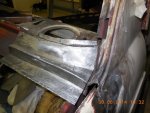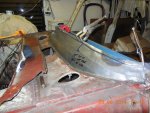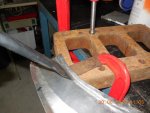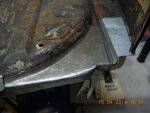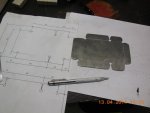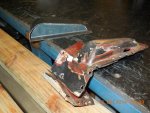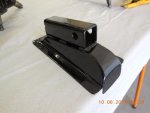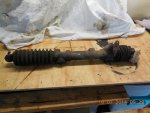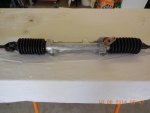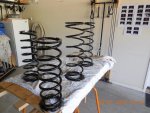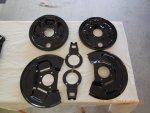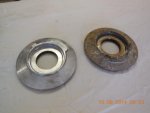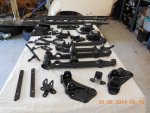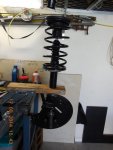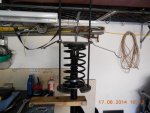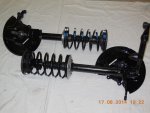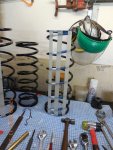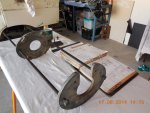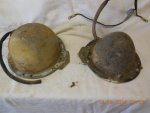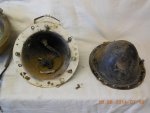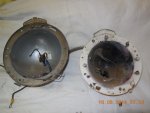It has been awhile since I’ve been able to get any serious work done on my 404. Now I’m on holidays, I should get a good crack at it over the next few weeks.
As previously stated there is a fair amount of rust under the windscreen on both sides. The to date, I’ve removed the bay window panel, the bonnet bracket support panel and finally the panel that seals the outside vents into the cabin (?). As this part is no longer available (wishful thinking), it will need to be formed from scratch. Besides being bowed across the front and tapered up on both sides, it also has three different inclines. Because of this, it was decided to make a fibreglass mould just in case the original panel was too badly distorted when removing.
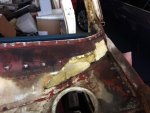
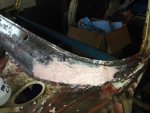
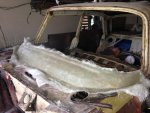
A friend suggested that the panel be tape with brown plastic packing tape to help with the mould releasing process. It was thought that the glass might adhere to firmly to the rusted and pitted surface. Once taped a releasing agent wax was applied. Combined it worked a treat the mould came away nicely. A few air bubbles etc, but in the main, a pretty good mould was produced.
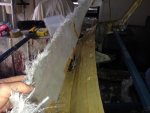
The remaining spot welds were drilled out and the panel was removed. To my surprise, this panel is quite thin, maybe .7 of a mm. The mould and panel will be taken to a friend’s engineering/fabrication workshop and he’ll produce a new one using the parts as templates.
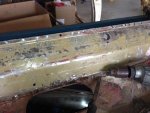
When the panel was removed, the true extent of the rust damage was revealed, the remaining drain panel will require some patchwork as well. There is more rust on the folded section that runs down into the air vent channel and the vertical dash panel. The dash panel will be cut away (About 200 mm) on both corners to get to the rusted sections. This rust was where water over the years has seeped in under the original body filler used to seal the panel during assembly. To be honest the whole corner section where all these panels meet is just plain ugly and all brazed together to give it some strength. In a document about assembling the 404 (in French), I received from the Peugeot Museum, it gives instructions on how to hold it altogether with brazing. Interestingly it also depicts all the various spot welding tips required to complete the assembly of the whole car. There are only four official measurements for aligning the body. They are, between the holes where the cross member bolts onto the chassis rails, between the strut tower mounts on the inner guards, the diagonals across the engine bay and the rear fin from the taillight tip to the base of the rear windscreen. The last measurement has a tolerance on +/- 5mm. Nothing like a bit of accuracy!
The company who is going to do sandblast the body suggests soaking the body in an acidic solution of some type (not sure of the name) to help make the process easier and get into all the cracks and crevices. Sounds logical, but I am a little dubious about what this will do to all the original red undercoat within the various channel sections of the chassis, ie roof panels A,B&C pillars, the side sills etc… If it etches the paint away, how would you get back into there to reprime it……… I would appreciate any feedback suggestions about this.
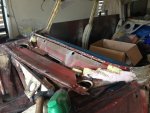
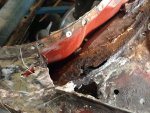
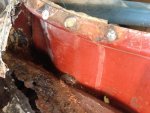
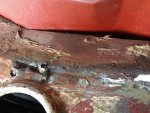
Keep you posted on my slow process.
Dano
As previously stated there is a fair amount of rust under the windscreen on both sides. The to date, I’ve removed the bay window panel, the bonnet bracket support panel and finally the panel that seals the outside vents into the cabin (?). As this part is no longer available (wishful thinking), it will need to be formed from scratch. Besides being bowed across the front and tapered up on both sides, it also has three different inclines. Because of this, it was decided to make a fibreglass mould just in case the original panel was too badly distorted when removing.



A friend suggested that the panel be tape with brown plastic packing tape to help with the mould releasing process. It was thought that the glass might adhere to firmly to the rusted and pitted surface. Once taped a releasing agent wax was applied. Combined it worked a treat the mould came away nicely. A few air bubbles etc, but in the main, a pretty good mould was produced.

The remaining spot welds were drilled out and the panel was removed. To my surprise, this panel is quite thin, maybe .7 of a mm. The mould and panel will be taken to a friend’s engineering/fabrication workshop and he’ll produce a new one using the parts as templates.

When the panel was removed, the true extent of the rust damage was revealed, the remaining drain panel will require some patchwork as well. There is more rust on the folded section that runs down into the air vent channel and the vertical dash panel. The dash panel will be cut away (About 200 mm) on both corners to get to the rusted sections. This rust was where water over the years has seeped in under the original body filler used to seal the panel during assembly. To be honest the whole corner section where all these panels meet is just plain ugly and all brazed together to give it some strength. In a document about assembling the 404 (in French), I received from the Peugeot Museum, it gives instructions on how to hold it altogether with brazing. Interestingly it also depicts all the various spot welding tips required to complete the assembly of the whole car. There are only four official measurements for aligning the body. They are, between the holes where the cross member bolts onto the chassis rails, between the strut tower mounts on the inner guards, the diagonals across the engine bay and the rear fin from the taillight tip to the base of the rear windscreen. The last measurement has a tolerance on +/- 5mm. Nothing like a bit of accuracy!
The company who is going to do sandblast the body suggests soaking the body in an acidic solution of some type (not sure of the name) to help make the process easier and get into all the cracks and crevices. Sounds logical, but I am a little dubious about what this will do to all the original red undercoat within the various channel sections of the chassis, ie roof panels A,B&C pillars, the side sills etc… If it etches the paint away, how would you get back into there to reprime it……… I would appreciate any feedback suggestions about this.




Keep you posted on my slow process.
Dano

